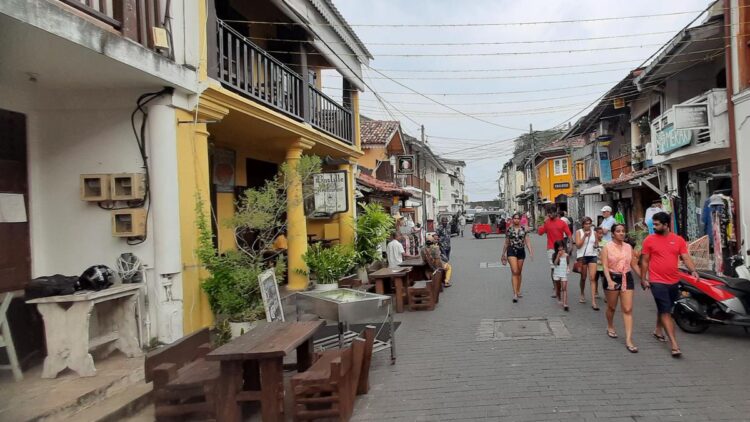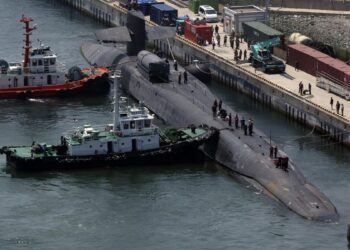[ad_1]

While more people are visiting, business could be better, say cafe owners and small traders in Galle, a tourist hotspot in southern Sri Lanka.
| Photo Credit: Meera Srinivasan
At the close of 2022, crisis-hit Sri Lanka had recorded nearly 7.2 lakh tourist arrivals — more than three times the number seen in 2021, even if nowhere close to the country’s pre-pandemic mark of nearly 20 lakh visitors.
While authorities and the tourism industry pitched the modest, yet promising, figure as a sure sign of economic recovery, many in Galle, a tourism hotspot along the island’s southern coast, say their trade and lives have not looked more uncertain. On a recent weekday, the usually thriving fort — also a functional heritage site with district courts, government museums and offices — was hardly teeming with visitors.
It was Taraka Jayasinghe Gunasekara’s first substantial hire in many days, from the neighbouring Matara district to Galle. As his clients toured the ramparts around town, built by the Portuguese five centuries ago and later fortified by the Dutch, the 35-year-old is waiting in his autorickshaw, staring at his phone.
“I am trying to see if I can join some language classes, like Korean, or maybe some skills training course. Otherwise, I can’t find a job abroad,” he says. The three-wheeler driver’s matter-of-fact admission echoes the thinking of many young Sri Lankans, especially those in the employable age bracket. The crushing economic meltdown last year prompted over 3 lakh Sri Lankans to leave, a record high in official outmigration figures on the island. Hundreds of others opted for perilous boat rides to faraway shores. If they left despite the well-known precarity around economic migration, it is not for the want of trying.
Mr. Gunasekara himself moonlights as an electrician. “We are a family of four, with two small children. We have not had milk tea in ages, and very rarely get to eat a piece of fish with our meal, when a friend shares his catch. If things don’t change, what future do we have in this country?” he asks. For many, things have not changed much in the past few months. Long queues for essentials have disappeared, supplies have been restored, and street protests have ended, but many Sri Lankans like him are struggling to cope with the dramatic rise in living costs.
“They say our crisis has ended, but for whom? An egg costs 70 rupees (about ₹16) today. I went for a medical test, they charged me 3,800 rupees. Our politicians just don’t care,” says a 74-year-old employee at a gem store. “Don’t mention my name, they’ll put me behind bars. See what happened to Wasantha Mudalige,” he adds at once, referring to a prominent student leader currently detained under Sri Lanka’s much-feared terrorism law for over 150 days. The senior citizen’s quick price chart of essentials is now a common talking point in Sri Lanka.
Asked if the gem trade is seeing improvement, he notes: “Not really”. Official tourist arrivals reflect a sharp rise since 2021, but the impact is yet to be felt, according to locals, especially small traders, reliant on the tourism industry.
The war effect
A.G. Jayantha is seated by the Galle Fort selling wooden statues of mostly fishermen and elephants. “Before the pandemic, I’ve even made upto 50,000 [Sri Lankan] rupees (roughly ₹ 11,000) on good days. But now, making even a few thousands is hard. We don’t get as many tourists, and not all tourists come to spend money.” Russian tourists, he says, are posing a peculiar challenge. “Some of them have stayed here for five or six months, perhaps fearing conscription back home. They seem to have some problem using their credit cards here, so they operate with very little cash and buy only essential items like bread and vegetables,” he says.
Restaurant owners operating inside Galle Fort voice similar concerns about the unexpected ways in which a distant war is affecting their own, civil-warred scarred island. “We are surely seeing more tourists now compared to the pandemic years, but we are not seeing more business. Russian tourists are coming in, but many of them don’t dine at restaurants. They walk around or go to the small kades (shops),” said an employee at a café.
As many as 91,272 Russian tourists entered Sri Lanka this year, official data shows, moving Russia up to the second spot among Sri Lanka’s main tourism markets, after India, which has remained the island’s largest source market. China was also a key market until the pandemic, and Sri Lankan tour operators are hoping that China resuming outbound tourism brings good news for tourism in the island. Last year’s financial meltdown is the latest blow to the industry, following the Easter Sunday bombings of 2019, and the pandemic in 2020 and 2021. The resilient sector earned over a billion dollars in 2022, and authorities are about to launch a global promotion soon to boost tourism revenue that is crucial for the country’s economic revival.
Also read: Despite challenges, Sri Lanka adapts to continue welcoming tourists
Wrapping up her ten-day visit to Sri Lanka, Swiss tourist Alexandra Von Gunten says she is keen to come back. “It’s our honeymoon. A friend of ours told us this is one of the best places to visit. We decided to travel here after watching some stunning videos on the Internet,” she says, seated at an ice cream joint inside Galle Fort. The young couple travelled to the hill country, key historic spots, and a national park, before heading to the southern beaches. “We really enjoyed exploring all these places, but my personal favourite was the national park.” Although aware of Sri Lanka’s crisis, she “didn’t feel it anywhere,” she says.
[ad_2]
















